Effectiveness of Strengthening RC Beams Using Composite Materials—An Accelerated Strengthening Method
Abstract
1. Introduction
2. Materials and Method 1
2.1. Evaluation of the Possibility of Accelerating Strengthening Time Using CFRP Strips in the NSMR Method
2.1.1. Accelerated Strengthening Procedure—Components Used
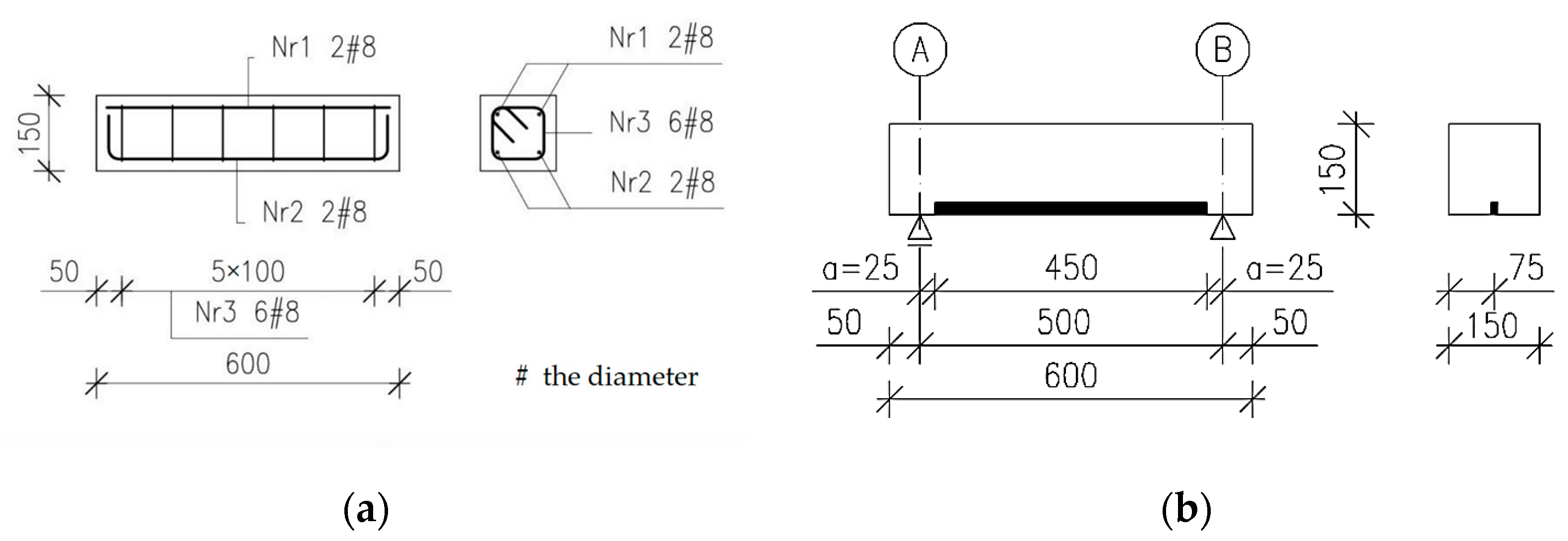
2.1.2. Testing
2.1.3. Result 1
- the use of strip heating in the NSMR method significantly reduces the adhesive hardening process from 7 days to 1.5 h, thereby reducing the duration of the entire component strengthening process;
- the adhesive cure time of 1.5 h and a strip heating temperature of 70 °C are optimal for strengthening RC elements with near surface mounted CFRP strips; the prototype heating device used in the study makes it possible to significantly reduce the adhesive cure time.
3. Materials and Method 2
3.1. Research on the Effectiveness of Strengthening Reinforced Concrete Beams Using the Optimal Temperature and Time of Heating CFRP Strips
3.1.1. Test Stand
3.1.2. Tested Elements
3.1.3. Loading Program and Strengthening of Elements
4. Results 2
4.1. Beam Failure Mechanism
4.2. Strengthening Level of the Beams
4.3. Effect of Heating the Strip—Accelerated Strengthening Process
5. Discussion
- Strengthening RC beams under load on soffits in the NSM method increases the failure load compared to non-strengthened beams.
- The use of strip heating reduces the adhesive cure time.
- The strip heating temperature of 70 °C established in the research can be taken as the optimal temperature used to reduce the adhesive cure time.
- A temperature of 70 °C maintained while heating the strips for 1.5 h is sufficient to effectively reduce adhesive cure time.
- Reducing the adhesive cure time by heating the composite strip results in satisfactory strengthening efficiency.
- Increased breaking load was observed in the case of both methods (accelerated and non-accelerated).
- The efficiency of strengthening RC beams with and without heating composite strips for bonding in the NSM method depends on the steel reinforcement ratio.
- Strip heating significantly increases the strengthening level compared to that of beams where no heating was used.
- The use of strip heating during strengthening of RC beams increases the value of deflections at the load level corresponding to the breaking force in relation to the deflections of strengthened beams where heating was not used. This confirms the achievement of greater reinforcement efficiency with the accelerated strengthening method.
6. Conclusions
Author Contributions
Funding
Institutional Review Board Statement
Informed Consent Statement
Data Availability Statement
Acknowledgments
Conflicts of Interest
References
- Golias, E.; Zapris, A.G.; Kytinou, V.K.; Kalogeropoulos, G.I.; Chalioris, C.E.; Karayannis, C.G. Effectiveness of the Novel Rehabilitation Method of Seismically Damaged RC Joints Using C-FRP Ropes and Comparison with Widely Applied Method Using C-FRP Sheets—Experimental Investigation. Sustainability 2021, 13, 6454. [Google Scholar] [CrossRef]
- Karayannis, C.; Golias, E.; Kalogeropoulos, G.I. Influence of Carbon Fiber-Reinforced Ropes Applied as External Diagonal Reinforcement on the Shear Deformation of RC Joints. Fibers 2022, 10, 28. [Google Scholar] [CrossRef]
- Saadatmanesh, H.; Ehsani, M.R. RC beams strengthened with GFRP plates. I: Experimental study. J. Struct. Eng. 1991, 117, 3417–3433. [Google Scholar] [CrossRef]
- Täljsten, B. Plate Bonding: Strengthening of Existing Concrete Structures with Epoxy Bonded Plates of Steel or Fibre Reinforced Plastics. Ph.D. Thesis, Luleå University of Technology, Luleå, Sweden, 1994; p. 190. [Google Scholar]
- Meier, U. Strengthening of structures using carbon fibre/epoxy composites. Constr. Build. Mater. 1995, 9, 341–351. [Google Scholar] [CrossRef]
- Labossière, P.; Neale, K.W.; Rochette, P.; Demers, M.; Lamothe, P.; Lapierre, P.; Desgagné, G. Fibre reinforced polymer strengthening of the Sainte-Émélie-de-l’Énergie bridge: Design, instrumentation, and field testing. Can. J. Civ. Eng. 2000, 27, 916–927. [Google Scholar] [CrossRef]
- Meier, U. Composite Materials in Bridge Repair. Appl. Compos. Mater. 2000, 7, 75–94. [Google Scholar] [CrossRef]
- Walser, R.; Steiner, W. Strengthening a Bridge with Advanced Materials. Struct. Eng. Int. 1997, 7, 110–112. [Google Scholar] [CrossRef]
- Yang, Y.; Sneed, L.; Saiidi, M.S.; Belarbi, A.; Ehsani, M.; He, R. Emergency repair of an RC bridge column with fractured bars using externally bonded prefabricated thin CFRP laminates and CFRP strips. Compos. Struct. 2015, 133, 727–738. [Google Scholar] [CrossRef]
- Barros, J.A.O.; Dias, S.J.E.; Lima, J.L.T. Efficacy of CFRP-based techniques for the flexural and shear strengthening of concrete beams. Cem. Concr. Compos. 2007, 29, 203–217. [Google Scholar] [CrossRef]
- Motavalli, M.; Czaderski, C. FRP composites for retrofitting of existing civil structures in Europe: State on the art review. In International Conference of Composites & Polycon; American Composites Manufacturers Association: Tampa, FL, USA, 2007. [Google Scholar]
- Sarker, P.; Begum, M.; Nasrin, S. Fiber reinforced polymers for structural retrofitting: A review. J. Civ. Eng. 2011, 39, 49–57. [Google Scholar]
- Lopez, A.; Nanni, A. Composite strengthening technologies. Concr. Int. 2006, 28, 74–80. [Google Scholar]
- Kałuża, M.; Ajdukiewicz, A. Comparison of behaviour of concrete beams with passive and active strengthening by means of CFRP strips. Archit. Civ. Eng. Environ. 2008, 1, 51–64. [Google Scholar]
- Kotynia, R. Przegląd metod wzmacniania konstrukcji żelbetowych przy użyciu materiałów kompozytowych. Inżynieria Bud. 2022, 78, 115–503. (In Polish) [Google Scholar]
- Kotynia, R.; Walendziak, R.; Stoecklin, I.; Meier, U. RC Slabs Strengthened with Prestressed and Gradually Anchored CFRP Strips under Monotonic and Cyclic Loading. J. Compos. Constr. 2011, 15, 168–180. [Google Scholar] [CrossRef]
- Product Information Sheet Sika Poland Sp. Zoo. Prestressing Systems for Structural Strengthening with Sika® CarboDur® CFRP Plates. Available online: https://swe.sika.com/dms/getdocument.get/b31c5318-a5e6-38c8-a495-f1ecaa66b374/Prestressing (accessed on 1 April 2023).
- Blaschko, M.; Zilch, K. Rehabilitation of concrete structures with CFRP strips glued into slits. In Proceedings of the Twelfth International Conference of Composite Materials, ICCM 12, Paris, France, 5–9 July 1999. [Google Scholar]
- Barros, J.; Fortes, A. Concrete Beams Reinforced with Carbon Laminate Strips Bonded into Slits. Métodos Numéricos en Ingeniería V, SEMNI. 2002. Available online: https://repositorium.sdum.uminho.pt/handle/1822/12759 (accessed on 1 May 2023).
- Castro, E.K.; Melo, G.S.; Nagato, Y. Flexural strengthening of RC T—Beams with near surface mounted (NSM) FRP reinforcement. In Proceedings of the International Symposium on FRP Reinforcement of Concrete Structures (FRPRCS-8), Patras, Greece, 16–18 July 2007. [Google Scholar]
- El-Hacha, R.; Rizkalla, S.H. Near-Surface-Mounted Fiber-Reinforced Polymer Reinforcement for Flexural Strengthening of Concrete Structures. ACI Struct. J. 2004, 101, 717–726. [Google Scholar]
- Kotynia, R. Flexural behaviour of reinforced concrete beams strengthened with near surface mounted CFRP strips. In Proceedings of the Third International Conference on FRP Composites in Civil Engineering, CICE, Miami, FL, USA, 13–15 December 2006. [Google Scholar]
- Costa, I.G.; Barros, J.A.O. Flexural and shear strengthening of RC beams with composite materials—The influence of cutting steel stirrups to install CFRP strips. Cem. Concr. Compos. 2010, 32, 544–553. [Google Scholar] [CrossRef]
- Barros, J.A.O.; Fortes, A.S. Flexural strengthening of concrete beams witch CFRP laminates bonded into slits. Cem. Concr. Compos. 2005, 27, 471–480. [Google Scholar] [CrossRef]
- Sharaky, I.A.; Torres, L.; Comas, J.; Barris, C. Flexural response of reinforced concrete (RC) beams strengthened with near surface mounted (NSM) fibre reinforced polymer (FRP) bars. Compos. Struct. 2014, 109, 8–22. [Google Scholar] [CrossRef]
- Hassan, T.; Rizkalla, S. Investigation of bond in concrete structures strengthened with near surface mounted carbon fiber reinforced polymer strips. ASCE J. Compos. Constr. 2003, 7, 248–257. [Google Scholar] [CrossRef]
- Kotynia, R. Analysis of reinforced concrete beams strengthened with near surface mounted FRP reinforcement. Arch. Civ. Eng. 2006, 52, 305–317. [Google Scholar]
- Product Information Sheet Sika Poland Sp. Zoo. Sika® CarboDur® Heating Device. Rapid Application of CarboDur® Plates.
- Product Information Sheet Sika Poland Sp. Zoo.—Sikadur®–330. Available online: https://pol.sika.com/content/dam/dms/plcon/e/sikadur_-330.pdf (accessed on 1 June 2021).
- Product Information Sheet Sika Poland Sp. Zoo. Sika®CarboDur® S NSM. Available online: https://pol.sika.com/content/dam/dms/plcon/f/sika_carbodur_s_nsm.pdf (accessed on 1 December 2020).
- Bereska, B.; Iłowska, J.; Czaja, K.; Bereska, A. Hardeners for epoxy resins. Przemysł Chem. 2014, 443–448. (In Polish) [Google Scholar]
- Goszczyńska, B.; Trąmpczyński, W.; Michałowska-Maziejuk, D. Accelerated method of reinforced concrete component strengthening with carbon fiber strips. In Proceedings of the IABSE Conference: Creativity and Collaboration—Instilling Imagination and Innovation in Structural Design, Bath, UK, 19–20 April 2017; pp. 212–213. [Google Scholar]
- Michałowska-Maziejuk, D.; Goszczyńska, B.; Trąmpczyński, W. Effectiveness of strengthening pre-loaded RC beams with CFRP strips in conventional and accelerated strengthening procedures. MATEC Web Conf. 2019, 284, 06005. [Google Scholar] [CrossRef]
- Product Information Sheet Sika Poland Sp. Zoo. Sika®CarboHeater for the Rapid Curing of Ska®CarboDur® Plates. Available online: https://www.google.com/search?client=firefox-b-d&q=Sika%C2%AECarboHeater+for+the+Rapid+Curing+of+Ska%C2%AECarboDur%C2%AE+Plates (accessed on 1 January 2004).
- Product Information Sheet Sika Poland Sp. Zoo. Sika CarboHeater. Urządzenie Przyśpieszające Wiązanie Klejów w Systemach Sika®CarboDur®. Sika Poland Sp. Zoo. 10 October 2013. (In Polish). Available online: https://www.google.com/search?client=firefox-b-d&q=Sika%C2%AECarboHeater+for+the+Rapid+Curing+of+Ska%C2%AECarboDur%C2%AE+Plates (accessed on 22 October 2019).
- Dąbrowski, K.; Stachurski, W.; Zieliński, J.L. Concrete Structures; Publisher: Arkady Publishing House, Warsaw, 1976. (In Polish) [Google Scholar]
- Baier, A. Zalecenia Stosowania Systemu Sika®CarboDur® NSM do Wzmacniania Konstrukcji Zbrojeniem Przypowierzchniowym Sika Services AG. 7 May 2011, pp. 1–13. Available online: https://www.google.com/url?sa=t&rct=j&q=&esrc=s&source=web&cd=&cad=rja&uact=8&ved=2ahUKEwjK-bbeqfD_AhU5S_EDHffWCEkQFnoECBsQAQ&url=https%3A%2F%2Fpol.sika.com%2Fcontent%2Fdam%2Fdms%2Fplcon%2F2%2FMS_2011_05_Sika%2520CarboDur_NSM_PL.pdf&usg=AOvVaw2v7iKHwk-3JYsKpHDoIXCr&opi=89978449 (accessed on 1 May 2023).
- Kamińska, M.; Kotynia, R. Experimental Research on RC Beams Strengthened with CFRP Strips; Department of Concrete Structures Technical University of Lodz: Lodz, Poland, 2000; Volume 9. [Google Scholar]
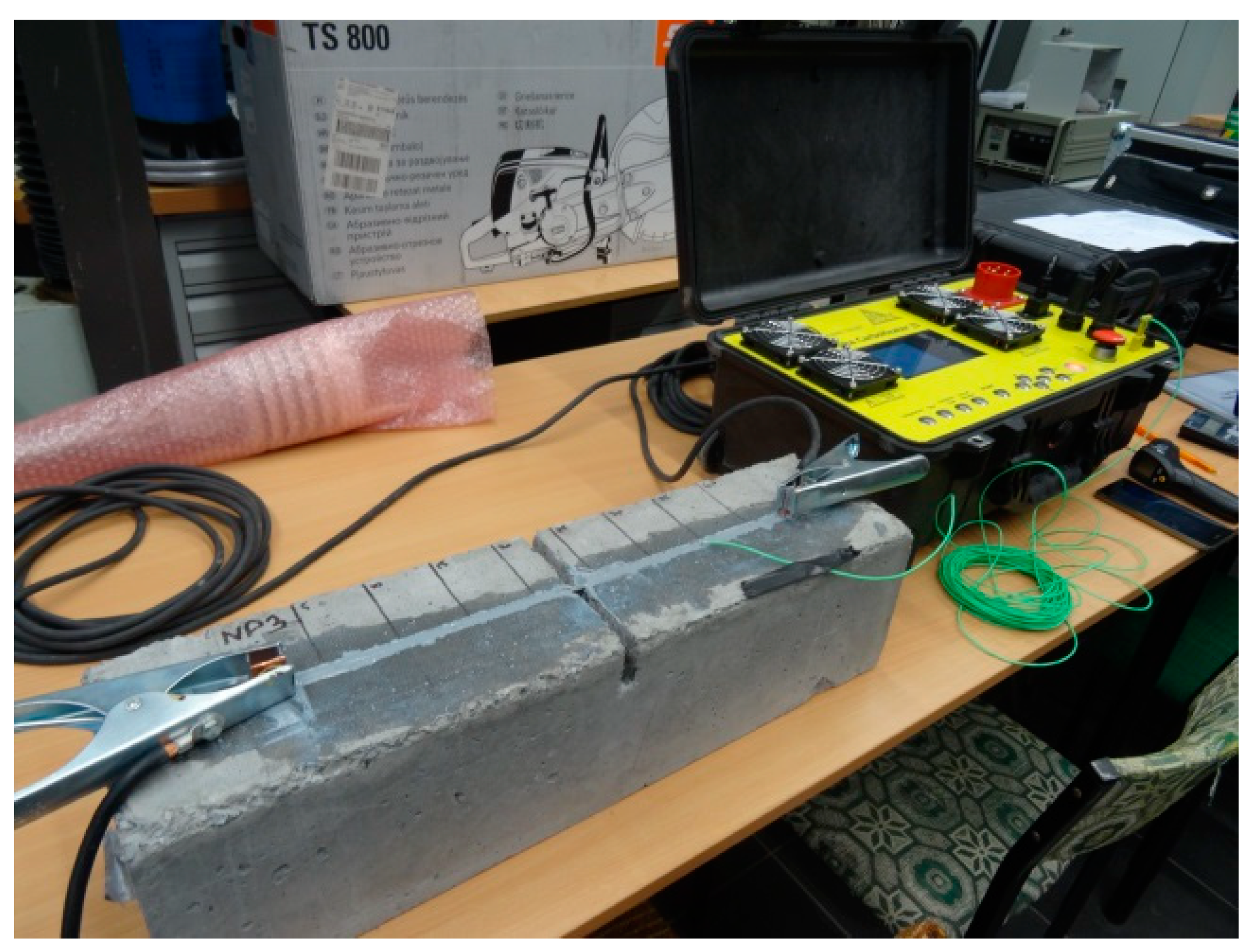

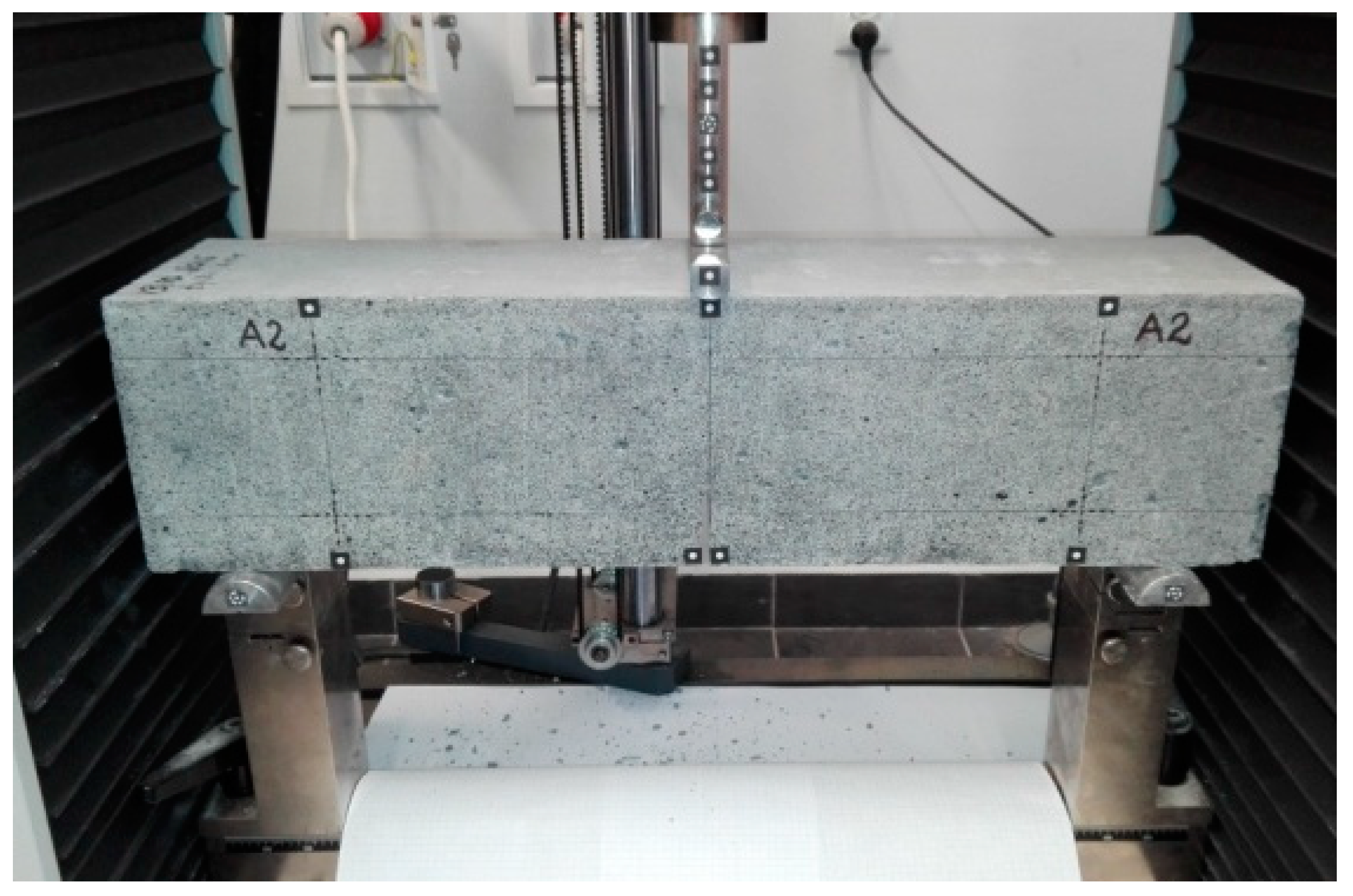

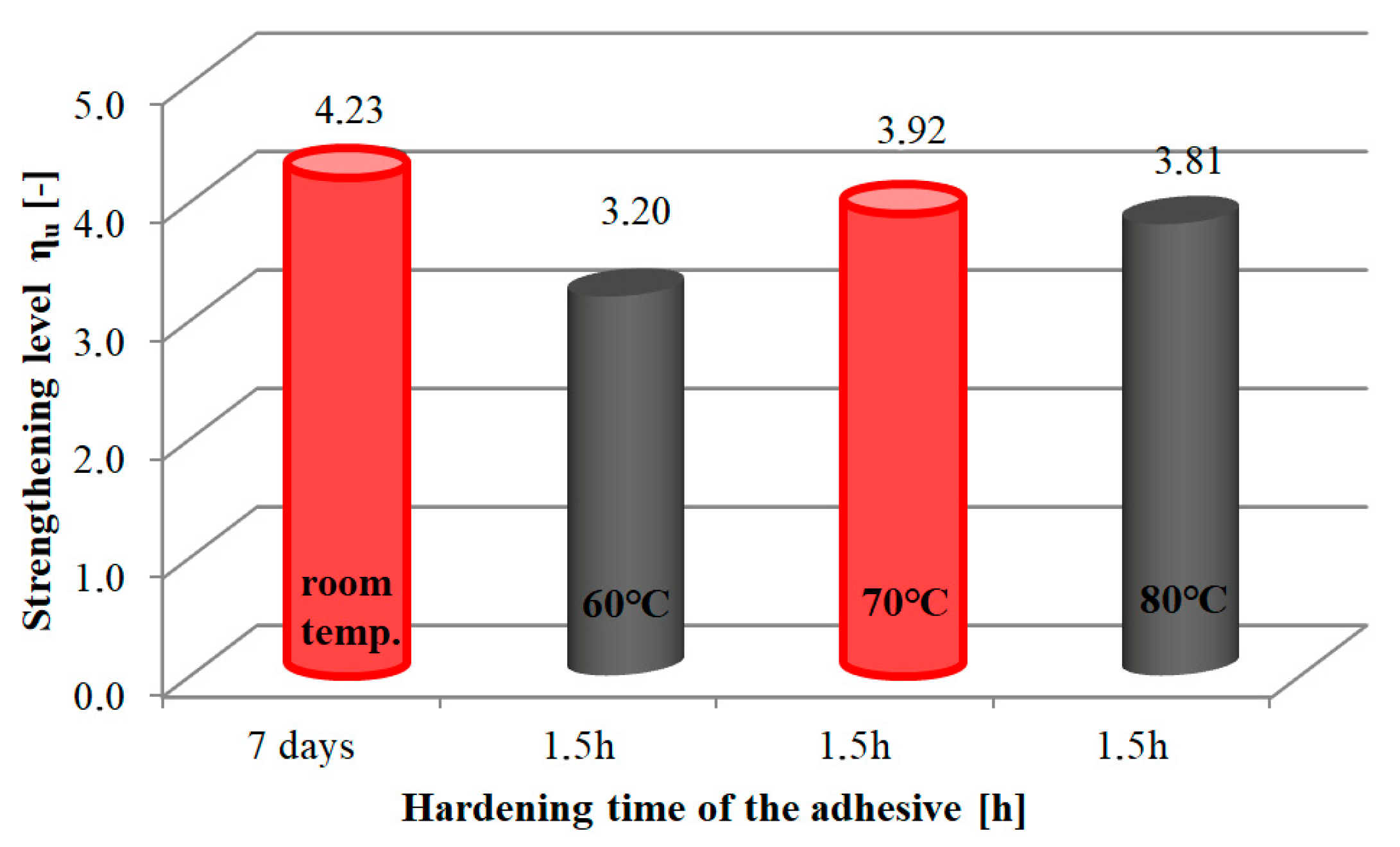
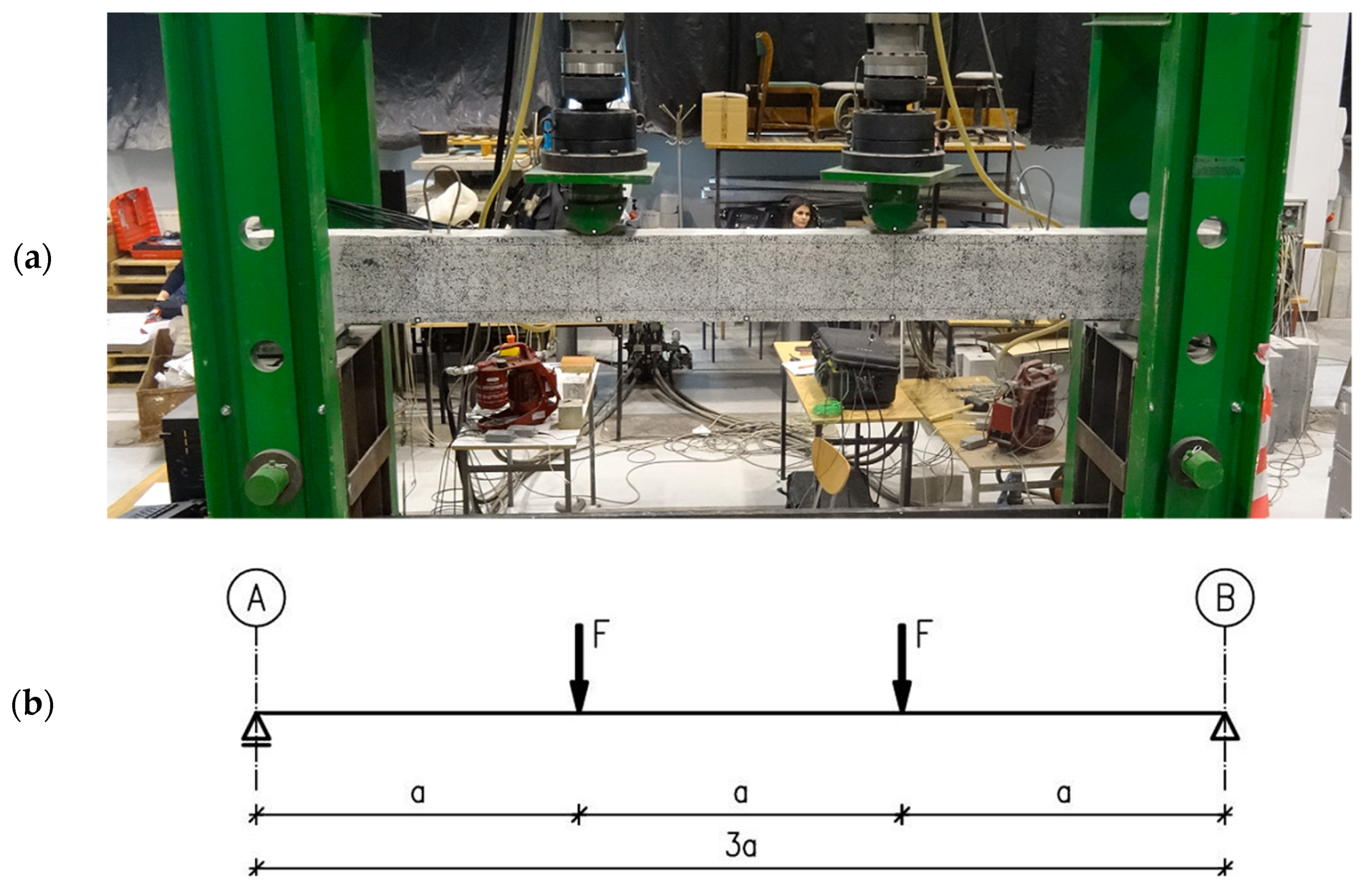
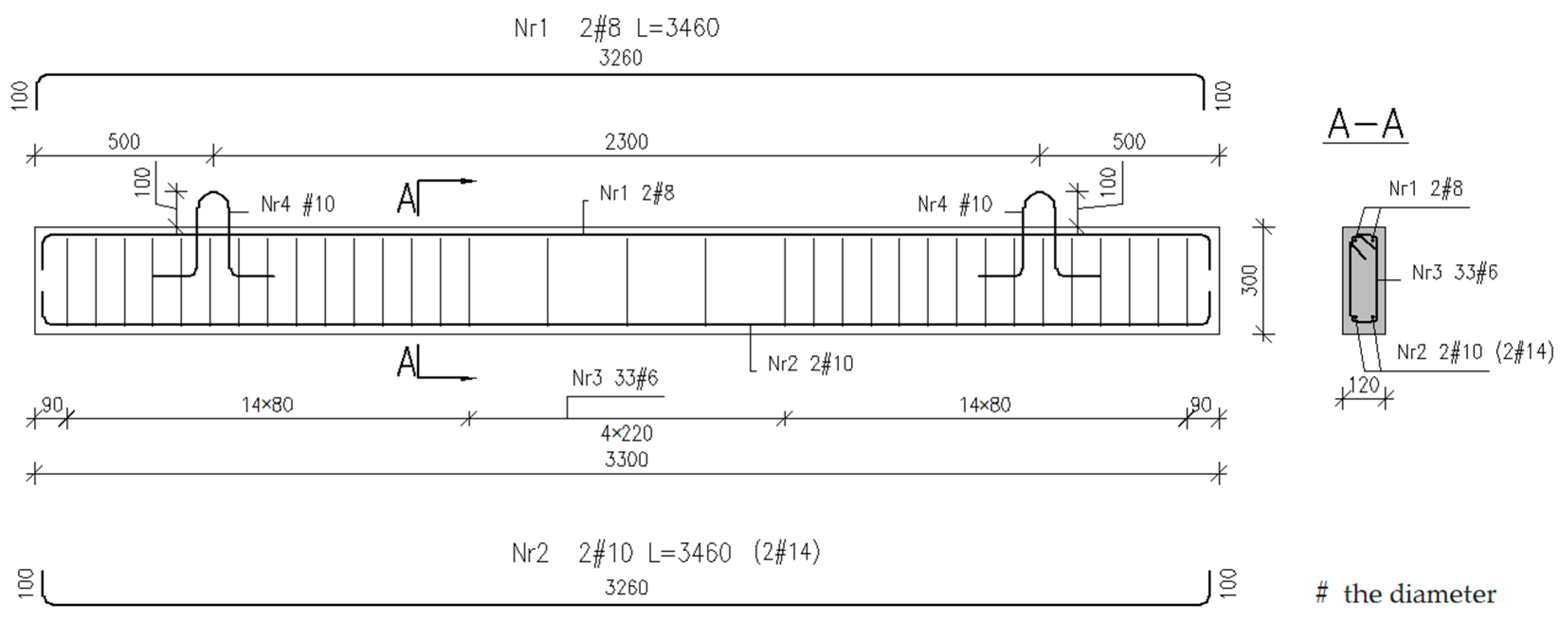
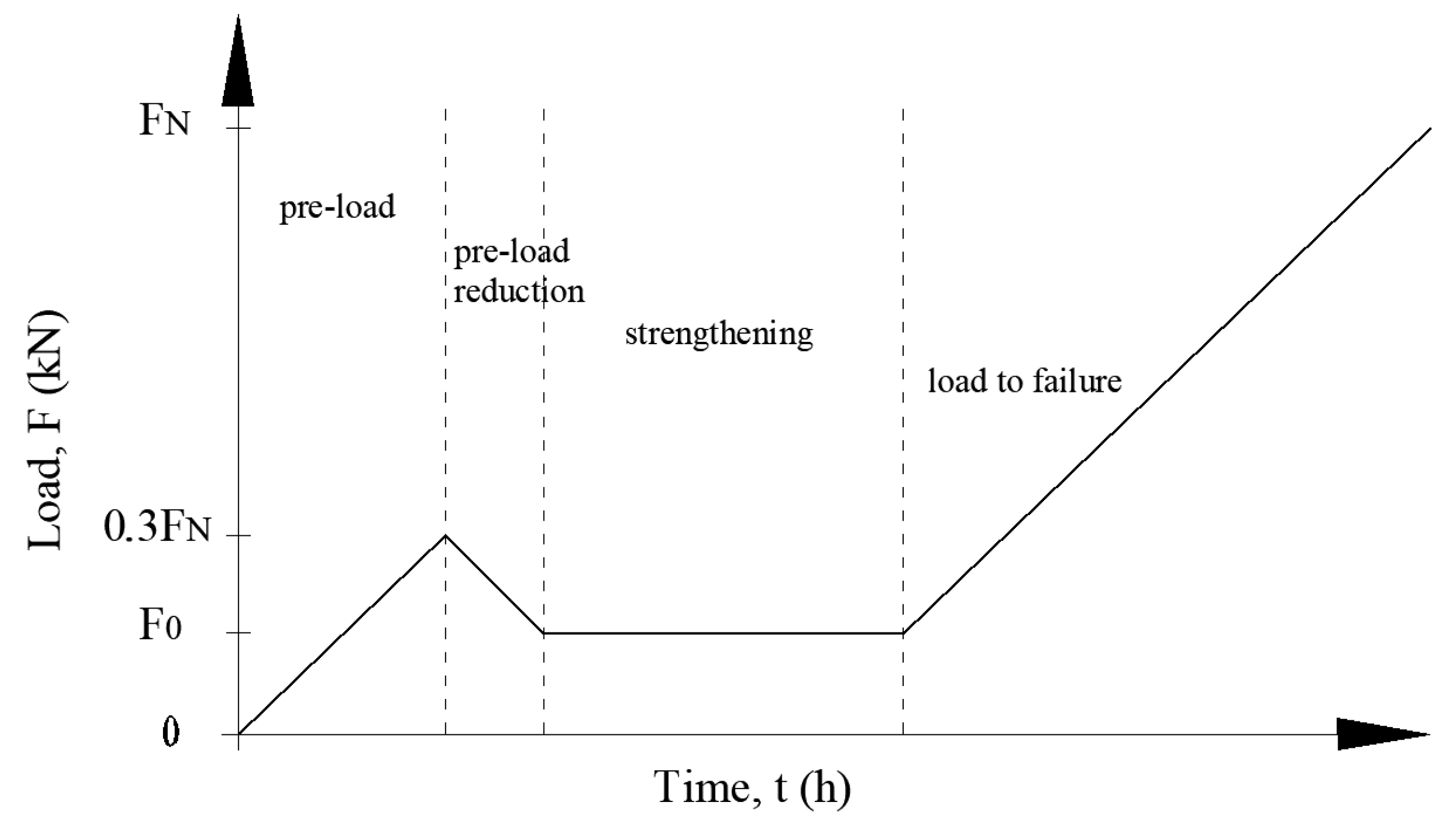
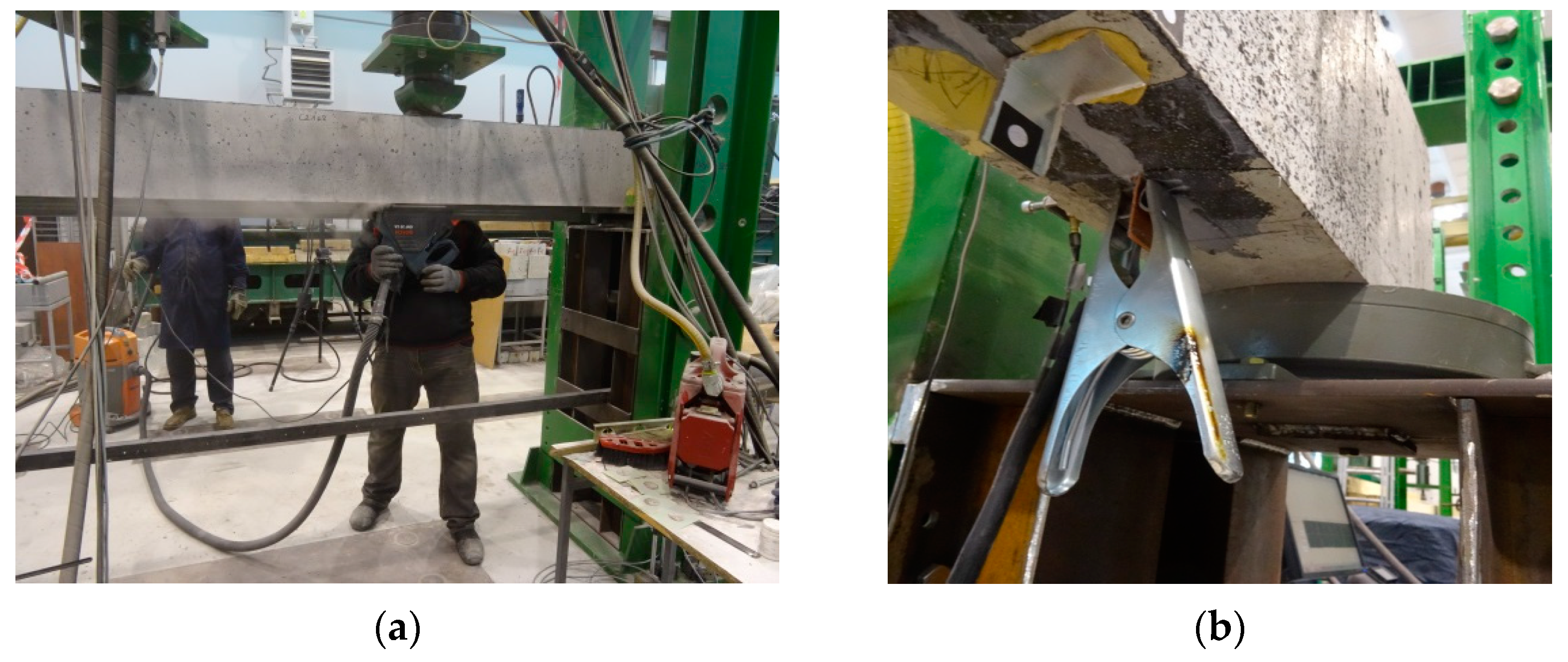
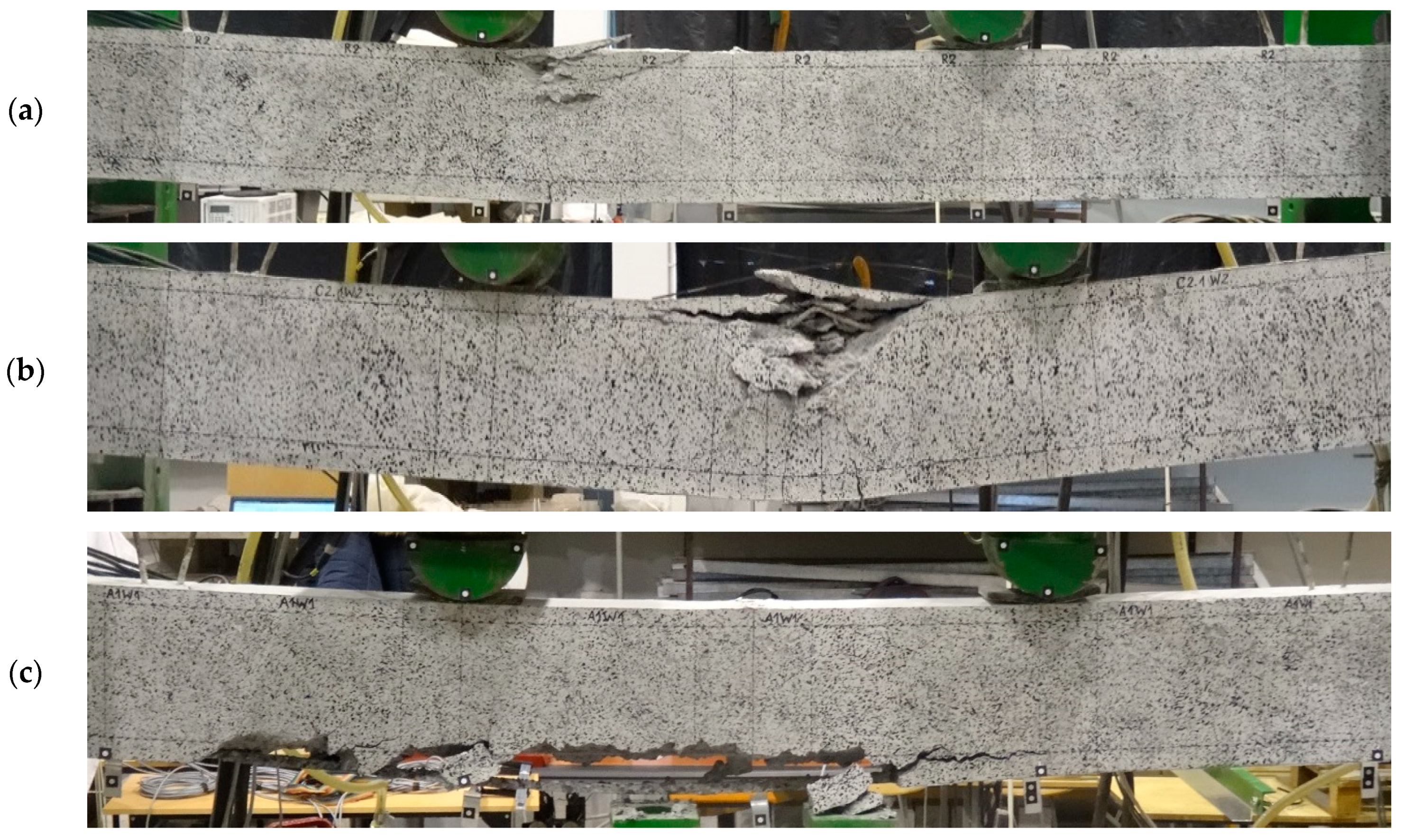
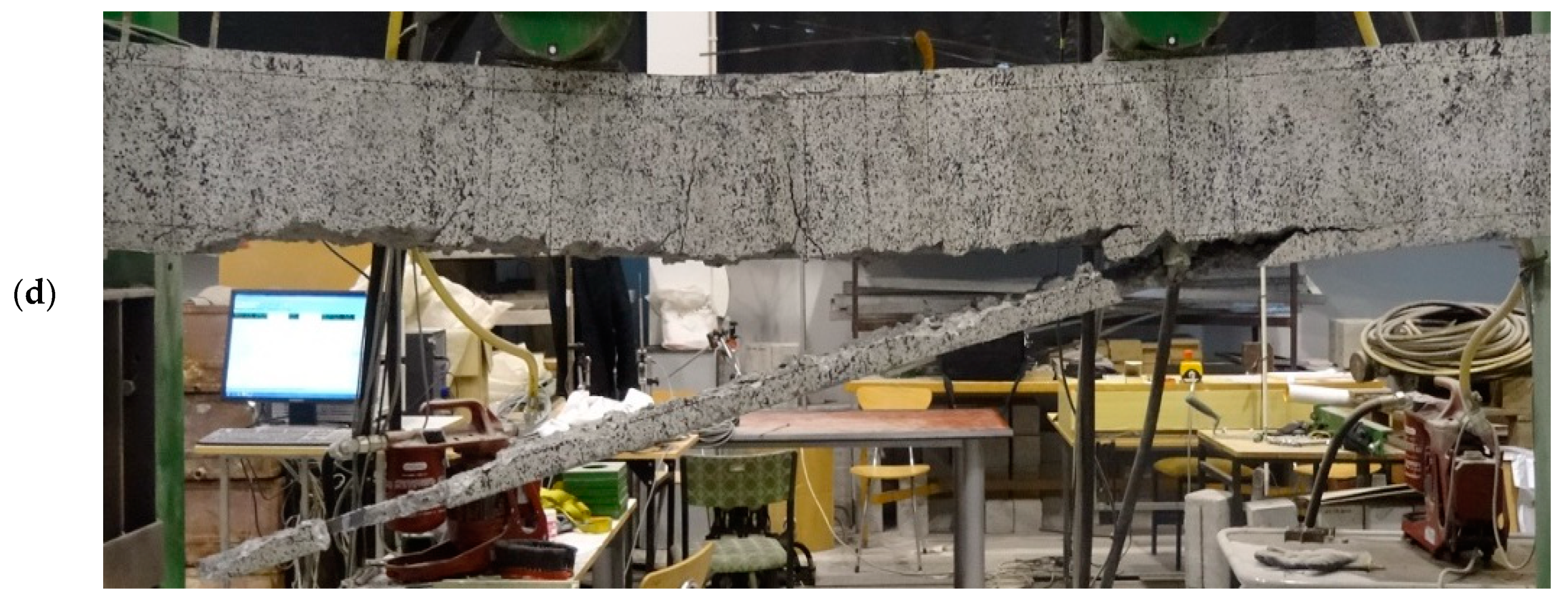

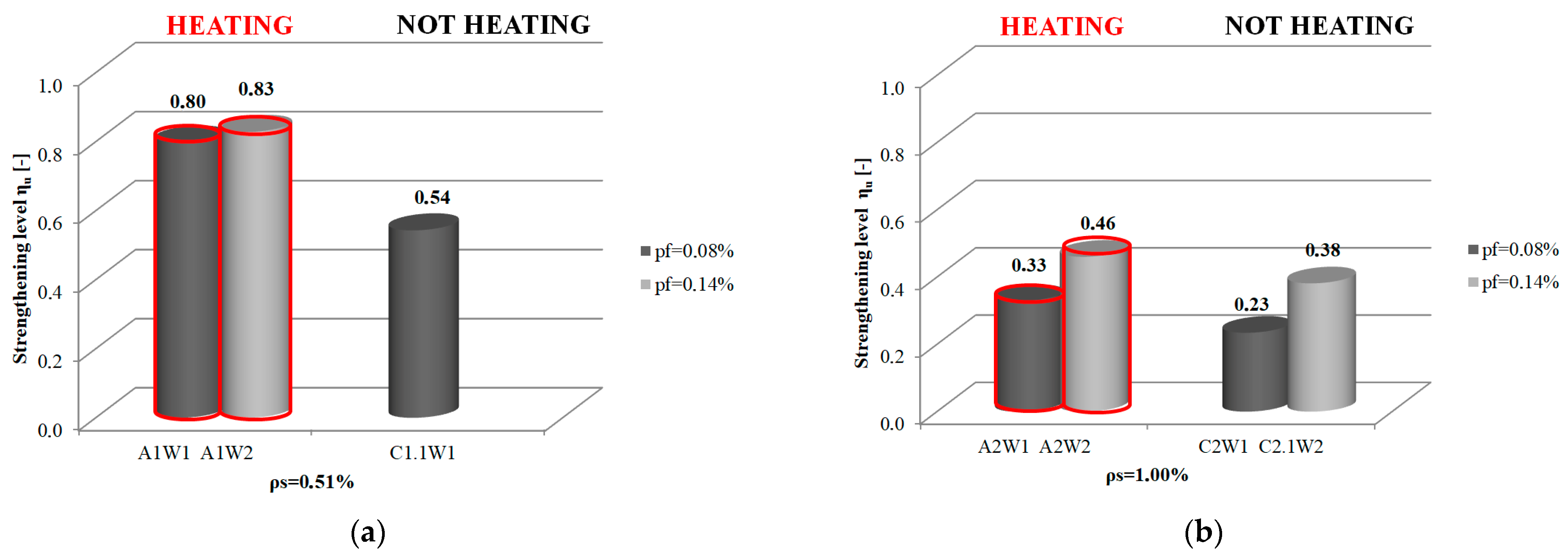
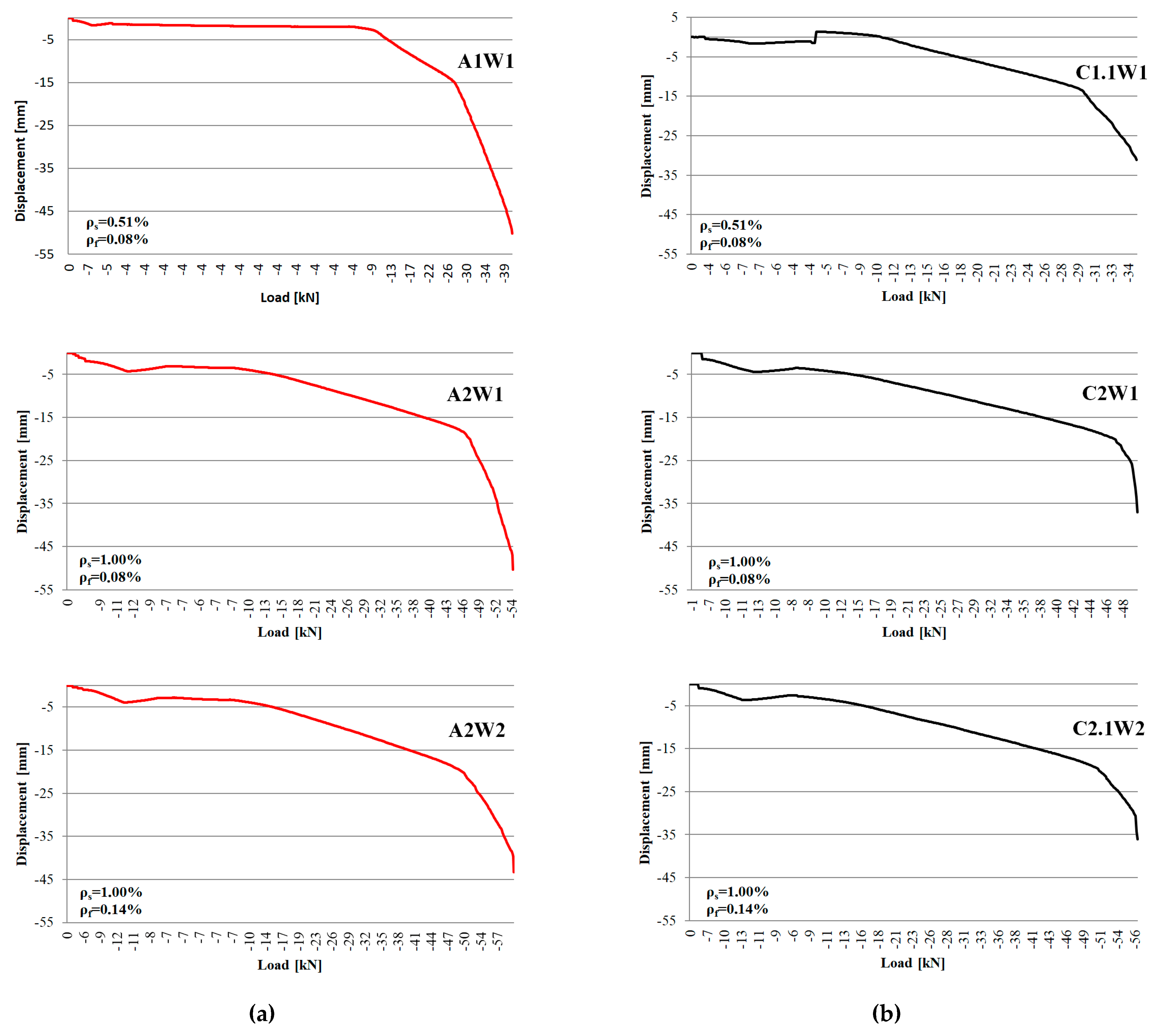
| Series | Elements | Adhesive Cure Time [h] | Adhesive Cure Temperature [℃] |
|---|---|---|---|
| 1 1 | A1÷A3 | - | - |
| 2 | B1÷B3 | 1.5 | 60 |
| 3 | C1÷C3 | 1.5 | 70 |
| 4 | D1÷D3 | 1.5 | 80 |
| 5 | E1÷E3 | 168.0 (7 days) | - |
| Series | Tested Elements | FN [kN] 1 | MN [kNm] 2 | MNśr [kNm] 3 | ηu |
|---|---|---|---|---|---|
| 1 | A1 | 10.9 | 1.36 | 1.40 | - |
| A2 | 11.5 | 1.44 | |||
| A3 | 11.3 | 1.41 | |||
| 2 | B1 | 44.6 | 5.58 | 5.90 | 3.20 |
| B2 | 48.8 | 6.10 | |||
| B3 | 48.1 | 6.01 | |||
| 3 | C1 | 54.9 | 6.86 | 6.90 | 3.92 |
| C2 | 56.9 | 7.11 | |||
| C3 | 53.9 | 6.74 | |||
| 4 | D1 | 51.8 | 6.48 | 6.75 | 3.81 |
| D2 | 56.8 | 7.10 | |||
| D3 | 53.5 | 6.69 | |||
| 5 | E1 | 59.5 | 7.44 | 7.35 | 4.23 |
| E2 | 57.5 | 7.19 | |||
| E3 | 59.3 | 7.41 |
| Series | Beams | Rebar in Compression/Tension | CFRP Strip n × tf × bf [mm] | Adhesive Cure Time [h] | Adhesive Cure Temperature [℃] |
|---|---|---|---|---|---|
| 1 | R1 | 2#8/2#10 1 | - | - | - |
| A1W1 | 1 × 10 × 3.0 | 1.5 | 70 | ||
| A1W2 | 1 × 20 × 2.5 | 1.5 | 70 | ||
| C1.1W1 | 1 × 10 × 3.0 | 168.0 (7 days) | 23 | ||
| C1W2 | 1 × 20 × 2.5 | 168.0 (7 days) | 23 | ||
| 2 | R2 | 2#8/2#14 1 | - | - | - |
| A2W1 | 1 × 10 × 3.0 | 1.5 | 70 | ||
| A2W2 | 1 × 20 × 2.5 | 1.5 | 70 | ||
| C2W1 | 1 × 10 × 3.0 | 168.0 (7 days) | 23 | ||
| C2.1W2 | 1 × 20 × 2.5 | 168.0 (7 days) | 23 |
| Series | Elements | ρs [%] | ρf [%] | FN [kN] | MN [kNm] | ηu |
|---|---|---|---|---|---|---|
| 1 | R1 | 0.51 | - | 22.61 | 22.61 | - |
| A1W1 | 0.08 | 40.65 | 40.65 | 0.80 | ||
| A1W2 | 0.14 | 41.34 | 41.34 | 0.83 | ||
| C1.1W1 | 0.08 | 34.89 | 34.89 | 0.54 | ||
| C1W2 | 0.14 | 44.02 | 44.02 | 0.95 | ||
| 2 | R2 | 1.00 | - | 41.06 | 41.06 | - |
| A2W1 | 0.08 | 54.54 | 54.54 | 0.33 | ||
| A2W2 | 0.14 | 59.97 | 59.97 | 0.46 | ||
| C2W1 | 0.08 | 50.69 | 50.69 | 0.23 | ||
| C2.1W2 | 0.14 | 56.72 | 56.72 | 0.38 |
Disclaimer/Publisher’s Note: The statements, opinions and data contained in all publications are solely those of the individual author(s) and contributor(s) and not of MDPI and/or the editor(s). MDPI and/or the editor(s) disclaim responsibility for any injury to people or property resulting from any ideas, methods, instructions or products referred to in the content. |
© 2023 by the authors. Licensee MDPI, Basel, Switzerland. This article is an open access article distributed under the terms and conditions of the Creative Commons Attribution (CC BY) license (https://creativecommons.org/licenses/by/4.0/).
Share and Cite
Michałowska-Maziejuk, D.; Goszczyńska, B. Effectiveness of Strengthening RC Beams Using Composite Materials—An Accelerated Strengthening Method. Materials 2023, 16, 4847. https://doi.org/10.3390/ma16134847
Michałowska-Maziejuk D, Goszczyńska B. Effectiveness of Strengthening RC Beams Using Composite Materials—An Accelerated Strengthening Method. Materials. 2023; 16(13):4847. https://doi.org/10.3390/ma16134847
Chicago/Turabian StyleMichałowska-Maziejuk, Dorota, and Barbara Goszczyńska. 2023. "Effectiveness of Strengthening RC Beams Using Composite Materials—An Accelerated Strengthening Method" Materials 16, no. 13: 4847. https://doi.org/10.3390/ma16134847
APA StyleMichałowska-Maziejuk, D., & Goszczyńska, B. (2023). Effectiveness of Strengthening RC Beams Using Composite Materials—An Accelerated Strengthening Method. Materials, 16(13), 4847. https://doi.org/10.3390/ma16134847






